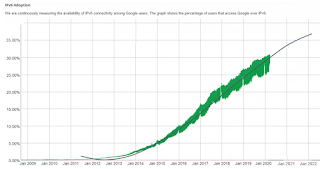Covid-19 and IPv6 Usage
With increasing numbers of white collar workers hunkering down within their homes across the globe over the past couple of weeks, full time working from home is becoming the norm - at least while Corona virus social distancing measures are in place. I was curious how this shift in worker locale might impact IPv6 usage around the world. One popular benchmark is Google's IPv6 statistics, which measures the percentage of IPv6 browser connections to its websites.
Over the 12+ years of data points within the graph, the data has exhibited a periodicity with a relative spike on weekend days and nominally lower percentage values during workdays. This leads one to surmise that remote users, when at home, more often connect via IPv6 than when in the office. This theory is supported by the sustained higher percentages of IPv6 utilization during the Christmas holidays in late December and now during the general Corona virus lockdown with the variance between weekday and weekend day percentages narrowing as you can see in the graph above.
It's too early to tell if this current remote work environment will cause a rise in the overall IPv6 proportion of Internet users. But looking back further throughout the entire data set, the general trend conveys a gentle rise up to about one-third of Internet users by the end of 2020 based on a third-order trend line shown in the figure below.
While this chart illustrates the global Internet penetration of IPv6, Google's per-country statistics indicate that many major western economies are well above this average; i.e., the U.K. is in the low 30% range, the U.S. and France are in the low 40% range and Germany is already above 50%. While no one knows for sure how long remote working will be required and even if it will become semi-normal policy after social distancing measures have been relaxed, the uptick in everyday IPv6 users buoyed by an observed gradual increase over time validates the wisdom of deploying IPv6 to prepare for this rising tide if you have not already done so.
It's too early to tell if this current remote work environment will cause a rise in the overall IPv6 proportion of Internet users. But looking back further throughout the entire data set, the general trend conveys a gentle rise up to about one-third of Internet users by the end of 2020 based on a third-order trend line shown in the figure below.
While this chart illustrates the global Internet penetration of IPv6, Google's per-country statistics indicate that many major western economies are well above this average; i.e., the U.K. is in the low 30% range, the U.S. and France are in the low 40% range and Germany is already above 50%. While no one knows for sure how long remote working will be required and even if it will become semi-normal policy after social distancing measures have been relaxed, the uptick in everyday IPv6 users buoyed by an observed gradual increase over time validates the wisdom of deploying IPv6 to prepare for this rising tide if you have not already done so.



Comments
Post a Comment